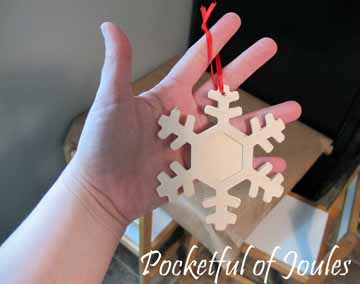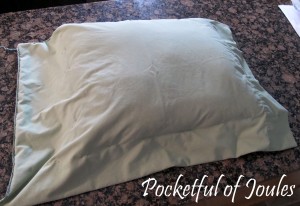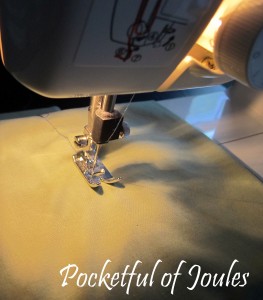When doing any DIY project, there is always an inherent danger in using a table saw or a razor blade improperly,
![Stitched up Thumb]()
or even using a large, unsecured pineapple that could hit you in the head and give you a concussion.
![Williamsburg Apple Fan Holiday Decoration]() Or even this: fortunately, I realized I had dipped my paintbrush in my coffee before I took another sip. In my defense, the coffee and the paint were almost exactly the same color…
Or even this: fortunately, I realized I had dipped my paintbrush in my coffee before I took another sip. In my defense, the coffee and the paint were almost exactly the same color…
![Paintbrush in Coffee Cup]() But recently, I came across this “Pin” for a collapsible spray painting tent made with PVC pipes and disposable clear plastic drop cloths from the DIY blog Makely School for Girls that gave me pause…
But recently, I came across this “Pin” for a collapsible spray painting tent made with PVC pipes and disposable clear plastic drop cloths from the DIY blog Makely School for Girls that gave me pause…
![Makely Collapsible Spray Tent]() What a great idea to be able to set up an enclosed area where you can spray, and then break it down and get it out of the way, right?! If you look closely at the tent, it is completely sealed on all sides, except for the double-draped opening. Which is the intention, after all, to contain the spray to a confined area, but clearly you also have to be inside the sealed tent while spraying. Now, on this blog, called Makely School for Girls (so adorable!) the writer repeatedly cautions everyone about being properly protected from fumes and spray,
What a great idea to be able to set up an enclosed area where you can spray, and then break it down and get it out of the way, right?! If you look closely at the tent, it is completely sealed on all sides, except for the double-draped opening. Which is the intention, after all, to contain the spray to a confined area, but clearly you also have to be inside the sealed tent while spraying. Now, on this blog, called Makely School for Girls (so adorable!) the writer repeatedly cautions everyone about being properly protected from fumes and spray, encouraging, no, demanding that anyone who builds and uses this tent must wear proper protective clothing to cover her/him AND a respirator (NOT one of those little surgical masks either-we are talking the big mask with an air vent-like this 3M Tekk Protection Demolition one from Home Depot.
![3M Respirator Mask @ Home Depot]()
(Imagine that $24.97is all it takes to keep you safe from harmful fumes!) In this post, the blogger, Lindsay Ballard’s cautions:
“*****IMPORTANT! I also need to say that you MUST wear a respirator![]() when you are in the tent. MUST, MUST, MUST. If you go in there without one, I’ll drive to your house and give you a stern talking to. And no, those little paper masks just won’t work. You should ALWAYS use a respirator for your projects if there’s any chance that some harmful particles (paint, wood sand, metal etc) will be in the air. Don’t make me hunt you down. Because I will. And I can be mean. Not really, but seriously. My granddaddy was a machinist and we are certain that the metal dust is what caused his lung disease. I also recommend wearing safety glasses (which you should be wearing anyway when you spray paint), nitrile/latex gloves and long sleeves/pants when you go in there (so you won’t be covered in a fine mist of paint yourself).”
when you are in the tent. MUST, MUST, MUST. If you go in there without one, I’ll drive to your house and give you a stern talking to. And no, those little paper masks just won’t work. You should ALWAYS use a respirator for your projects if there’s any chance that some harmful particles (paint, wood sand, metal etc) will be in the air. Don’t make me hunt you down. Because I will. And I can be mean. Not really, but seriously. My granddaddy was a machinist and we are certain that the metal dust is what caused his lung disease. I also recommend wearing safety glasses (which you should be wearing anyway when you spray paint), nitrile/latex gloves and long sleeves/pants when you go in there (so you won’t be covered in a fine mist of paint yourself).”
Kudos to the author for stressing the importance of proper protection and educating us all about the dangers of spray painting in an enclosed space. BUT, I know, myself, (and I am sure that there are many, many more guilty DIY’ers out there), and I might just be tempted to jump in there and spray one little thing without being hazmatted up.
![Cordova Defender Hazmat Suit Home Depot]()
Cordova Defender ll Microporous Suit from Home Depot
Because even now I sometimes just grab a can of spray adhesive or paint while working in my (essentially unvented) basement workshop and think, “oh, it’s just this little bit, It will be fine.” Well, its not, folks. Not in the least. These companies are putting the warnings on their products for a reason! Just for my own FYI, I grabbed a few of my favorite products that I use on a daily basis in my workshop and was astounded at the levels of toxicity present in so many cans and bottles of goop and spray and paints that I thought were completely safe!! Here are just a few samples- this one is from a little pot of latex paint. It contains Ethylene Glycol- the chemical they use to make anti-freeze & airplane de-icer . According to eHow:Ethylene Glycol is a colorless, odorless synthetic liquid substance used to make antifreeze and for de-icing airplanes and runways. Ethylene glycol breaks down in the body, producing poisons that can damage the brain, heart and kidneys. Even with medical treatment, swallowing antifreeze is often fatal. Read more: http://www.ehow.com/about_5977662_polyethylene-glycol-vs_-ethylene-glycol.html#ixzz2qk8hoEFC.
![Paint Pot Warning Label]()
Now clearly, I am not going to drink the stuff, unless, of course I happen to dip my paintbrush in it by mistake. But, breathing in stuff can be just as harmful. This is from my favorite spray adhesive:
![Spray Adhesive Warning Label]() Probably not the best decision to have a portable space heater right next to my work table… This label is from a popular brand of chalk paint:
Probably not the best decision to have a portable space heater right next to my work table… This label is from a popular brand of chalk paint:
![Chalk Paint Can Warning]() And this one is from a can of furniture refinisher that I like to use:
And this one is from a can of furniture refinisher that I like to use:
![Furniture Refinisher Label]() And this one from my “odorless mineral spirits” that I sometimes use to clean up brushes:
And this one from my “odorless mineral spirits” that I sometimes use to clean up brushes:
![Mineral Spirits Label]()
And finally this bottle of a cleaner/degreaser that I got at a natural food store to transfer prints onto wood. I saw this on a DIY show where the host actually put her nose to the bottle and took a deep breath to illustrate how non-toxic and great-smelling and harmless this stuff was! Yikes!
![Citrisolv Cleaner]() I looked up some of the ingredients on the above labels and this one scared the crap out of me!! Toluene: Toluene is primarily used as an octane-boosting additive to gasoline. It is also used as a solvent in paints, household aerosols, adhesives, solvent-based cleaning agents, and synthetic fragrances.
I looked up some of the ingredients on the above labels and this one scared the crap out of me!! Toluene: Toluene is primarily used as an octane-boosting additive to gasoline. It is also used as a solvent in paints, household aerosols, adhesives, solvent-based cleaning agents, and synthetic fragrances.
Read more: http://www.ehow.com/about_6530607_toluene-made_.html#ixzz2qk9mAbwC According to Wikipedia: “Inhalation of toluene in low to moderate levels can cause tiredness, confusion, weakness, drunken-type actions, memory loss, nausea, loss of appetite, and hearing and color vision loss. These symptoms usually disappear when exposure is stopped. Inhaling high levels of toluene in a short time may cause light-headedness, nausea, or sleepiness. It can also cause unconsciousness, and even death.” On top of that, I started thinking about all of the old furniture I have been working on, sanding and releasing particles into the air-that I am breathing in without a mask-that could very well be mold, old toxic chemicals and even lead paint. If you notice, all of the above labels contain warnings about making sure that your work area is properly ventilated, and the importance of wearing protective masks and clothing.
![Dangers poison]() So, enough label reading, time for action! What’s a DIY’er to do if you don’t have a vented workshop or an outdoor space you can use year-round? Well, for myself, a few decisions have been made and are being implemented immediately. No more spray painting or sanding or gluing in the basement, PERIOD. Until spring, when I can set up shop outdoors again, (at which time I may entertain the idea of a collapsible painting tent ala the Makely School for Girls project, because that is AWESOME : ) I am temporarily going to roll up the oriental rug and move my workshop to our upstairs living room (which is quite lovely, but essentially gets used once a year, on Thanksgiving. Hopefully, by then I will be moved out of our house and into a nice, open studio or workshop.)
So, enough label reading, time for action! What’s a DIY’er to do if you don’t have a vented workshop or an outdoor space you can use year-round? Well, for myself, a few decisions have been made and are being implemented immediately. No more spray painting or sanding or gluing in the basement, PERIOD. Until spring, when I can set up shop outdoors again, (at which time I may entertain the idea of a collapsible painting tent ala the Makely School for Girls project, because that is AWESOME : ) I am temporarily going to roll up the oriental rug and move my workshop to our upstairs living room (which is quite lovely, but essentially gets used once a year, on Thanksgiving. Hopefully, by then I will be moved out of our house and into a nice, open studio or workshop.)
![Living Room Fireplace PM]() This parlor has high ceilings, 4 windows for ventilation and a fake fireplace for a little ambiance : ). Electric sanding will be done outdoors, regardless of the temperature, and masks and gloves on from now on! Just out of curiosity, where do all of you DIY’ers do your painting, sanding and staining? Do you have the luxury of a beautiful, vented and well-lit workshop? Do you have any suggestions on the best place to DIY? And, on that note, gotta head to Home Depot to pick up my mask and gloves. I suggest, if you are planning on doing any future painting, gluing, sanding or staining DIY projects, that you do the same. Have a happy and non-toxic Sunday, everyone! Susan
This parlor has high ceilings, 4 windows for ventilation and a fake fireplace for a little ambiance : ). Electric sanding will be done outdoors, regardless of the temperature, and masks and gloves on from now on! Just out of curiosity, where do all of you DIY’ers do your painting, sanding and staining? Do you have the luxury of a beautiful, vented and well-lit workshop? Do you have any suggestions on the best place to DIY? And, on that note, gotta head to Home Depot to pick up my mask and gloves. I suggest, if you are planning on doing any future painting, gluing, sanding or staining DIY projects, that you do the same. Have a happy and non-toxic Sunday, everyone! Susan
http://countrydesignhome.com/2014/01/19/the-dangers-of-diy/



























































 Nothing motivates the creation of a poorly-made craft like the prospect of a good night’s sleep.
Nothing motivates the creation of a poorly-made craft like the prospect of a good night’s sleep. Miraculously, Elissa offers to help put Lily to bed – and tell her the full story of the dreamcatcher (hey…is it working its magic already??).
Miraculously, Elissa offers to help put Lily to bed – and tell her the full story of the dreamcatcher (hey…is it working its magic already??).






































